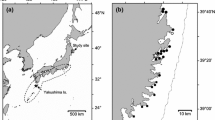Abstract
Swimming behaviour and dispersal patterns were studied in headstarted loggerhead turtles Caretta caretta which were released at three different sites on the Caribbean island of Curaçao (Netherlands Antilles) and at one site on the neighbouring island of Klein Curaçao, after 1–2.5 yrs of captivity. Turtles were tagged and followed up to a distance of 6125 m offshore, using a boat with a Global Positioning Unit. The released turtles reverted to typical hatchling behaviour and showed an offshore migration almost perpendicular to the coastline. No significant differences were found in directional swimming among the four sites. The turtles swam almost continuously about 30 cm under the water surface; their mean overall swimming speed was higher than in adult wild loggerheads suggesting a 'frenzy'-like swimming stage. The turtles exhibited diving behaviour, and the dive frequency and duration was comparable to that of similar-sized (wild) turtles. The present study demonstrates that upon release the headstarted loggerheads behave naturally and show dispersal patterns similar to wild hatchling turtles. The fact that the released turtles were still able to show offshore directional swimming suggests that the headstarting did not affect their short-term orientation abilities.
Similar content being viewed by others
References
Bolten A.B., Martins H.R., Natali M.L., Thome J.C. and Marcovaldi M.A. 1990. Loggerhead released in Brazil recaptured in Azores. Mar. Turtle Newsl. 48: 2–25.
Bowen B.W., Conant T.A. and Hopkins-Murphy S.R. 1994. Where are they now? The Kemp's ridley headstart project. Conserv. Biol. 8: 85–856.
Carr A. 1986. Rips, FADS, and little loggerheads. BioScience 36: 9–100.
Ehrenfeld D. 1974. Conserving the edible sea turtle: can mariculture help? Am. Sci. 62: 2–31.
Fontaine C.T., Manzella S.A., Williams T.D., Harris R.M. and Browning W.I. 1989. Distribution, growth and survival of head started, tagged, and released Kemp's ridley (Lepidochelys kempi) from year classes of 197–1983. In: Proc. 1st Int Symp Kemp's ridley sea turtle biol conserv management., pp. 12–144.
Frick J. 1967. Orientation and behaviour of hatchling green turtles (Chelonia mydas) in the sea. Anim. Behav. 24: 84–857.
Hays G.C., Webb P.I., Hayes J.P., Priede I.G. and French J. 1991. Satellite tracking of a loggerhead turtle (Caretta caretta) in the Mediterranean. J. Mar. Biol. Ass. UK 71: 74–746.
Keinath J.A. 1993. Movements and behavior of wild and headstarted sea turtles. PhD Dissertation, College of William and Mary, USA.
Light P., Salmon M. and Lohmann K.J. 1993. Geomagnetic orientation of loggerhead sea turtles: evidence for an inclination compass. J. Exp. Biol. 182: –10.
Lohmann K.J. 1991. Magnetic orientation by hatchling loggerhead sea turtles (Caretta caretta). J. Exp. Biol. 155: 3–49.
Lohmann K.J. and Lohmann C.M.F. 1996a. Orientation and open-sea navigation in sea turtles. J. Exp. Biol. 199: 7–81.
Lohmann K.J. and Lohmann C.M.F. 1996b. Detection of magnetic field intensity by sea turtles. Nature 380: 5–61.
Lohmann K.J., Swartz A.W. and Lohmann C.M.F. 1995. Perception of ocean wave direction by sea turtles. J. Exp. Biol. 198: 107–1085.
Lohmann K.J., Witherington B.E., Lohmann C.M.F. and Salmon M. 1997. Orientation, navigation, and natal beach homing in sea turtles. In: Lutz P.J. and Musick J.A. (eds), The Biology of Sea Turtles. CRC Press, Boca Raton, pp. 10–135.
Lutcavage M.E., Plotkin P., Witherington B. and Lutz P.L. 1997. Human impacts on sea turtle survival. In: Lutz P.J. and Musick J.A. (eds), The Biology of Sea Turtles. CRC Press, Boca Raton, pp. 38–409.
Lutz P.L. and Bentley T.B. 1985. Respiratory physiology of diving in the sea turtle. Copeia 1985: 67–679.
Manzella S.A., Bjorndal K. and Lagueux C. 1991. Head-started Kemp's ridley recaptured in Caribbean. Mar. Turtle Newsl. 54: 1–14.
Mrosovsky N. 1983. Conserving Sea Turtles. British Herpetological Society, London.
Musick J.A. and Limpus C.J. 1997. Habitat utilization and migration in juvenile sea turtles. In: Lutz P.J. and Musick J.A. (eds), The Biology of Sea Turtles. CRC Press, Boca Raton, pp. 13–163.
Pritchard P.C.H. 1980. The conservation of sea turtles: practices and problems. Amer. Zool. 20: 60–617.
Renaud M.L. and Carpenter J.A. 1994. Movements and submergence patterns of loggerhead turtles (Caretta caretta) in the Gulf of Mexico determined through satellite telemetry. Bull. Mar. Sci. 55: –15.
Sakamoto W., Sato K., Tanaka H. and Naito Y. 1993. Diving patterns and swimming environment of two loggerhead turtles during internesting. Nippon Suisan Gakkaishi 59: 112–1137.
Salmon M. and Lohmann K.J. 1989. Orientation cues used by hatchling loggerhead sea turtle (Caretta caretta L.) during their offshore migration. Ethology 83: 21–228.
Salmon M. and Wyneken J. 1987. Orientation and swimming behavior of hatchling loggerhead turtles Caretta caretta L. during their offshore migration. J. Exp. Mar. Biol. Ecol. 109: 13–153.
Stoneburner D.L. 1982. Satellite telemetry of loggerhead sea turtle movement in the Georgia Bight. Copeia 1982: 40–408.
Taubes G. 1992. A dubious battle to save Kemp's ridley sea turtles. Science 256: 61–616.
Walpole R.E. and Myers R.H. 1978. Probability and Statistics for Engineers and Scientists. 2nd edn. Macmillan Publ. Co., New York.
Witham R. 1980. The “lost year” question in young sea turtles. Amer. Zool. 20: 52–530.
Witham R., Gallagher R.M. and Hollinger M.L. 1973. Tracking green turtles with fluorescent dye. Prog. Fish Cult. 35: 23–240.
Witherington B.E. 1991. Orientation of hatchling loggerhead turtles at sea off artificially lighted and dark beaches. J. Exp. Mar. Biol. Ecol. 149: –11.
Wood F. and Wood J. 1993. Release and recapture of captive-reared green sea turtles Chelonia mydas, in the waters surrounding the Cayman Islands. Herpetol. J. 3: 8–89.
Woody J.B. 1991. Is' headstarting' a reasonable conservation measure? “On the surface, yes; in reality, no”. Mar. Turtle Newsl. 54: –8.
Wyneken J. and Salmon M. 1992. Frenzy and postfrenzy swimming activity in loggerhead, leatherback, and green sea turtles. Copeia 1992: 47–484.
Zar J.H. 1996. Biostatistical Analysis. 3rd edn. Prentice-Hall, New Jersey.
Author information
Authors and Affiliations
Corresponding author
Rights and permissions
About this article
Cite this article
Nagelkerken, I., Pors, L. & Hoetjes, P. Swimming behaviour and dispersal patterns of headstarted loggerhead turtles Caretta caretta . Aquatic Ecology 37, 183–190 (2003). https://doi.org/10.1023/A:1023924631480
Issue Date:
DOI: https://doi.org/10.1023/A:1023924631480




